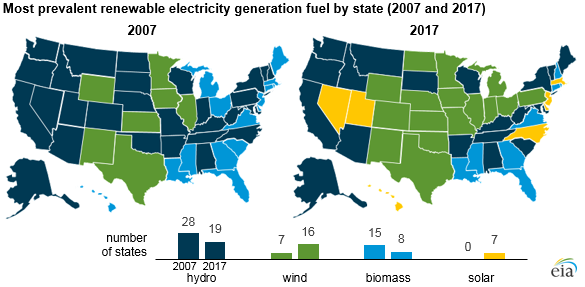

The US Energy Information Agency (EIA) recently published two interesting sets of maps to show how the US energy mix has changed state by state between 2007 and 2017.
That decade saw the rise of cheap natural gas that lead many utilities to switch away from coal, but the result is not as clear-cut as one might think: in some states, coal retirements resulted in nuclear power becoming the most-used energy source.
It’s also important to note that the maps below reflect electricity generation, not necessarily consumption. In some cases, what’s generated within state lines will be sold to neighboring states.
The first map
Between 2007 and 2017, the number of states for which coal was the most-used energy source fell from 28 to 18. That change was accompanied by a growth in the number of states that mostly used natural gas from 11 to 16, hydroelectricity from four to six, and nuclear power from six to nine. That’s interesting because hydroelectricity and nuclear power power plant additions have been close-to-stagnant for decades. In some states, nuclear power plants benefitted from “uprating,” or changes that increase the plant’s capacity. Uprating was rarely enough to counteract the whole loss of coal capacity in any given state, which means retired coal is either not being replaced because of electricity efficiency gains, or it’s being replaced by more diverse energy sources, like wind and solar.

Only one state moved away from natural gas between 2007 and 2017: Maine. There, the state ran its natural gas generation capacity less in 2017, allowing hydro to get out ahead.
The EIA notes that “Hydro is the only renewable energy source with the largest share in any state, but that may soon change with the continued addition of wind turbines in states such as Kansas and Iowa.”
The second map
The second map takes a look at the predominant form of renewable energy in each state in 2007 and in 2017. Here, we really see the growth of solar. In 2007, solar was the most-used renewable energy source in zero states, but by 2017, it had replaced biomass or hydro in seven states. Wind grew even more than solar over that decade, going from the predominant renewable source of electricity in seven states to the leader in 16 states.

Interestingly, hydro’s share of the renewable energy landscape played out a lot like coal’s over the past decade: hydro went from the most prevalent renewable resource in 28 states down to 19. But that’s not because hydro plants are getting retired—rather, hydro is losing ground to other energy sources because so much solar and wind power are coming online.
“In Maine and Vermont, the share of electricity generated by biomass trails only hydroelectricity, making them two of only three states where renewable fuels provided both of the top two generation shares,” the EIA wrote. “South Dakota, where hydroelectricity and wind were the most prevalent sources, is the third state.”









